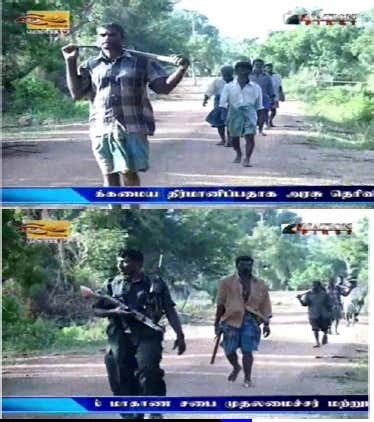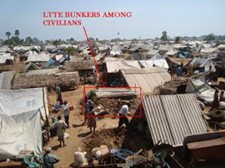ERASING THE EELAM VICTORY Part 21G
Posted on July 18th, 2021
KAMALIKA PIERIS
The Tamil Separatist Movement says that the Tamil civilian population in the north is an innocent group, who have suffered during the Eelam war IV. The Tamil people were the victims of the last phase of the war, said Jehan Perera. They lost their loved ones, lost their lands, their livelihoods. The Tamils are an aggrieved people, not aggressors. They suffered unjustly during the war, said the Eelamists.
Anti-Eelamists do not agree. They do not think that the Tamil civilians in the north were ‘innocent victims’. Tamil civilians in the north knowingly supported the LTTE in their Eelam war. They were Complicit”.
‘Complicit’ means involved with others in an activity that is unlawful or morally wrong”. To be complicit, means choosing to be involved in an illegal or questionable act with others. A person who is complicit is a person who participates in, or associates with people who are involved in, illegal activities.
Tamil civilians in the north became complicit because they supported the LTTE. LTTE was engaged in treason. The Tamil civilians were supportive of the LTTE throughout the Eelam war period. When the Ceasefire Agreement was signed and a LTTE administration was set up in the north the civilians eagerly joined the LTTE in opposing the Sri Lanka army. They joined the LTTE in demonstrating against the army camps and they treated the soldiers with contempt when they came in contact with them.
The Tamil civilians were most supportive, most complicit, in the last year of the war, (2009) when they obeyed the LTTE and marched in huge numbers towards the war zone in Putumatalan area. They left their homes and trekked east, voluntarily, on the routes ordered by the LTTE.
Analysts have pointed out that this was not the first time that the LTTE had forced a civilian population to accompany them as they retreated in the face of an army offensive. When the Army launched its Vadamarachchi operation in 1987, there was a large exodus of civilians through Varani to Thenmaratchy. When Operation Riviresa (1995) started LTTE had again instructed civilians to leave their homes. Tens of thousands left. Entire Valikamam area including Jaffna town was devoid of civilians.
The huge 2009 exodus was not necessary. The Tamil civilians need not have left their homes once the Sri Lanka army took control of the area. The Sri Lanka army did not follow a scorched earth policy. Once the army completed its takeover of a place, they handed that territory to non-combat forces and moved on. The Tamil civilians could therefore have continued to live comfortably in their own houses in the liberated areas.
But they did not do so. They ran towards the war zone in droves. This is most unusual. Is there any other instance in the world where civilians actually ran towards the fighting? Civilians usually try to escape from a war zone. Ordering the displacement of the civilian population for reasons not related to the conflict or the safety of the civilians is forbidden in ICRC rules.
It is extremely unlikely that 20,000 LTTE could have forced 330,000 civilians to follow them like this. It is far more likely that they would have gone voluntarily to play their part in the LTTE war, said Desmond de Silva and David M. Crane in their report to the Paranagama Commission .
The civilians first converged on Kilinochchi. Then around December 2008, LTTE forced 10,000 to 20,000 civilians into the coastal stretch extending between Ambalavanapokkani in the north to Vattavaakallu in the south in order to block the advance of the 55th and 59th Brigade. The first function of this migrating lot was therefore to block the advance of the army. They were acting as a buffer. Acting as a ‘buffer’ comes within the definition of performing hostile acts, said Paranagama Commission.
But that was not all. Analysts observed that that these civilians were marshaled by the LTTE from early 2009 for another purpose, to form a defense that would hold back the government forces and allow an international rescue operation by sea carried out by Norway and USA to take place.
The Tamil civilians cooperated fully, because they thought the LTTE would win, Eelam would be realized and they would return to their homes triumphantly. Interviewers reported that a good segment of those trapped believed that the West would intervene and save them and the LTTE.
The whole family, including aged relatives, made the journey. They went in buses, cars, and on foot. As late as 2012 it was possible to see large piles of corroding motor vehicles, motor cycles, and bicycles, parked on top of each other on either side of the road . The larger vehicles had numbers on them, observed critics. It was possible to see large swathes of land with thousand of abandoned plastic vessels, cooking utensils, clothing, shoes children books, and other personal items strewn around.
The Tamil civilians did not go on this journey empty handed. It was reported that the IDPs who came across at Puthumathalam, fleeing from the LTTE came with their land deeds tightly held. They also carried millions of rupees in cash and gold securely wrapped in pottanis. They had deposited a total of Rs. 390 million in the bank.
The civilians were in for a shock when they got to their destination. The LTTE used the civilians as human shields. This was known to the government, ICRC and those watching the war. Human Shielding is prohibited in Rule 97 of ICRC’s compendium of IHL Customary Rules. It is a war crime. Further, those used as human shields are actually participating in the war. They are playing a passive role, not an active one, but they are definitely a part of the war, said lawyer Michael Newton.
LTTE made good use of these civilians during the final stages of the armed conflict. Civilians, including children, were armed and forced into the front line, noted the Paranagama Commission. LTTE used the civilians to fortify the defenses by digging trenches, bunkers and building formidable earth bunds behind the lagoon. The civilians also did sentry duty, and carried supplies. Each family had several tasks like building bunkers, said an LTTE informant.


Fig 14: Pic of a crowded locality in the Last Redoubt marked by the SL military authorities for propaganda purposes — Pic supplied by Victor Ivan